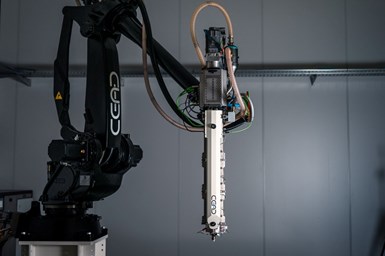CEAD and Adaxis Integrate Technologies for More Efficient Robotic Large Format 3D Printing
CEAD’s methodology for large-format 3D printing converges within Adaxis’ AdaOne software for the Flexbot platform, giving Flexbot users a smoother, more efficient experience with increased consistency, reliability and build quality, while minimizing potential issues.
Share
Read Next
CEAD, a provider of robotic large-format 3D printing solutions, has launched a partnership with Adaxis, a growing robotics software company. This collaboration aims to strengthen the integration of CEAD’s Flexbot solutions with Adaxis’ AdaOne software, offering customers a seamless experience for large-format 3D printing with composite materials.
Recognizing the increasing reliance on modern technologies, CEAD says it acknowledges the importance of close collaborations with software companies to elevate the performance, compatibility and functionality of its solutions.
CEAD aims to deliver a more advanced and user-friendly total solution for its customers by joining forces with Adaxis, a multinational team of innovators on a mission to change the way the world uses industrial robotics and enable manufacturing of more sustainable and innovative products. This collaboration has given rise to the official launch of “AdaOne for Flexbot,” a software integration for CEAD’s Flexbot systems.
“Cultivating shared values and a unified vision with the Adaxis team empowers us to innovate swiftly, steering our collaborative efforts toward the entire ecosystem of large format 3D printing,’’ says Maarten Logtenberg, CEAD co-founder and CTO.
The companies say the partnership enables innovative features in AdaOne for Flexbot. AdaOne for Flexbot introduces a range of features that include automatic raft generating and scan-to-mill functionalities.
There’s also automated secure fixation for part on the print bed. The raft generator is a feature that automatically creates rafts to secure parts to CEAD’s print bed, minimizing material use. This feature for Adaxis’ “AdaOne for Flexbot,” enhances the end-user convenience by ensuring parts remain securely fixated in place throughout the entire printing and postprocessing cycle.
Users can also benefit from automated generation of milling paths based on scan data of the printed part. The scan-to-mill workflow facilitates post-3D printing data collection, enabling the automatic generation of a milling path based on acquired data. Addressing the dynamic nature of 3D printing of large parts, this feature determines the optimal alignment between the CAD model and the printed part, ensuring a milling program that meets end-users’ requirements with minimal milling time and maximized remaining material thickness. Integrated into Flexbot’s automatic tool change system, scan-to-mill is designed to guarantee a seamless workflow.
The incorporation of these features in one software platform is aimed at enabling a faster adoption of large-format additive manufacturing. CEAD’s refined methodology for large-format 3D printing seamlessly converges within the AdaOne for Flexbot platform. It ensures Flexbot users a smoother, more efficient experience with increased consistency. But also, more reliability and build quality, while minimizing potential issues. This collaborative effort results in a software experience that seamlessly integrates with the Flexbot systems, elevating the overall 3D printing experience.
“Our collaboration with the CEAD team allows us to offer a seamless user experience that is instantly accessible, fully leveraging the technology, with a dedicated focus on promising applications,’’ says Guénolé Bras, Adaxis co-founder and CTO.
Related Content
-
Video: Construction 3D Printing with Robotics, Geopolymer
Alquist 3D is aiming to revolutionize construction and infrastructure with large-format robotic 3D printing using a carbon-neutral material.
-
“Mantis” AM System for Spacecraft Uses Induction for Deposition
The metal 3D printing system melts wire without lasers. 30-foot-diameter parts are built on a rotary-feed system that eliminates the need for a large machine frame or gantry.
-
Evaluating the Printability and Mechanical Properties of LFAM Regrind
A study conducted by SABIC and Local Motors identified potential for the reuse of scrap reinforced polymer from large-format additive manufacturing. As this method increases in popularity, sustainable practices for recycling excess materials is a burgeoning concern.















